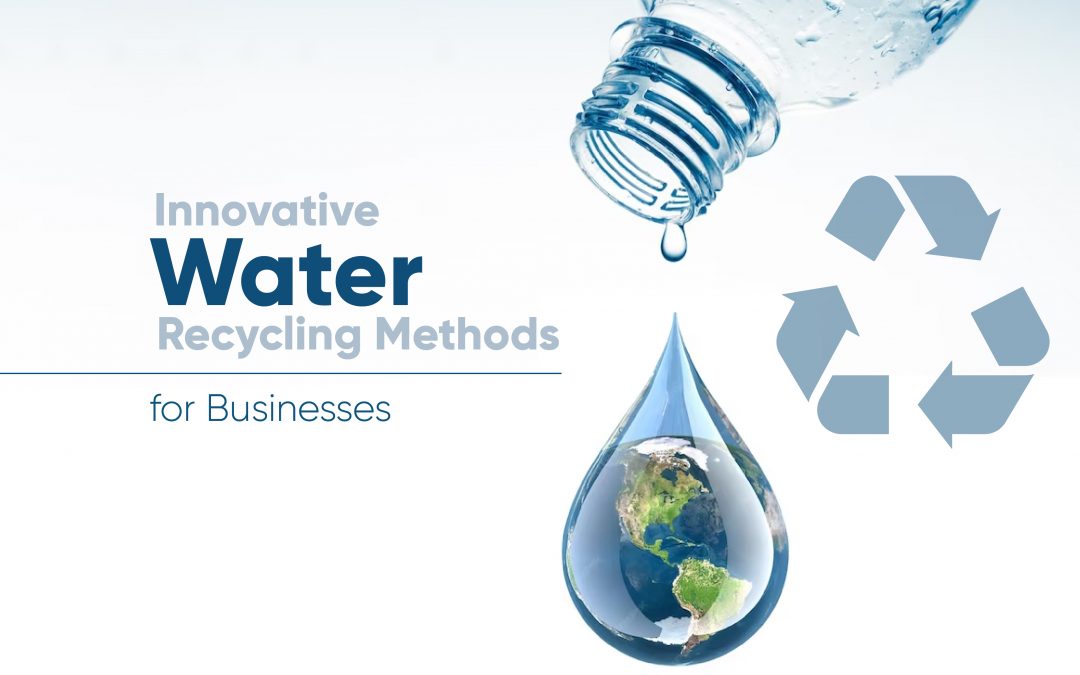Water scarcity is an escalating global issue, pushing businesses to adopt innovative water recycling methods. Implementing water recycling not only conserves this precious resource but also reduces operational costs and enhances sustainability efforts. Here’s a look at some of the most innovative water recycling methods that businesses can adopt.
1. Greywater Water Recycling Systems
Greywater recycling involves the collection and treatment of wastewater from sources such as sinks, showers, and washing machines. This treated greywater can be reused for non-potable purposes like irrigation, toilet flushing, and cooling systems. Businesses, especially those in hospitality and manufacturing, can significantly reduce their water consumption by implementing greywater recycling systems.
Example: A hotel chain installing greywater systems can reuse water from guest room showers for landscaping irrigation, thus cutting down on fresh water use and maintaining lush, green gardens.
Advanced Technologies:
- Biofiltration Systems: Utilizing biological processes involving microorganisms to treat greywater effectively.
- Electrocoagulation: Using electrical currents to remove suspended particles and contaminants from greywater.
- Advanced Oxidation Processes (AOPs): Employing strong oxidants such as ozone or hydrogen peroxide to degrade organic pollutants in greywater.
2. Rainwater Harvesting Systems
Rainwater harvesting captures and stores rainwater for later use. This method involves collecting rainwater from roofs or other surfaces and storing it in tanks. The harvested rainwater can be used for irrigation, flushing toilets, and even as cooling water in industrial processes.
Example: An office building can install rooftop rainwater harvesting systems to collect water, which can then be used to maintain the landscape or supply water for the cooling towers, significantly reducing municipal water demand.
Advanced Technologies:
- First Flush Diverters: These devices ensure the initial runoff, which may contain contaminants, is diverted from the storage tanks.
- Ultrafiltration Membranes: Providing high-level filtration to remove pathogens and fine particles from harvested rainwater.
- Smart Monitoring Systems: IoT-enabled sensors and controls for real-time monitoring of water quality and storage levels.
3. Membrane Filtration Systems
Membrane filtration systems use semi-permeable membranes to remove contaminants from water. Techniques such as reverse osmosis (RO), nanofiltration, and ultrafiltration are highly effective in treating industrial wastewater, making it suitable for reuse in various processes.
Example: A textile manufacturing plant can use reverse osmosis to treat wastewater, allowing the recycled water to be reused in the dyeing process, thus conserving large volumes of water.
Advanced Technologies:
- Nanofiltration (NF): A membrane filtration process that removes small organic molecules and divalent ions, providing high-quality treated water.
- Forward Osmosis (FO): Using a semipermeable membrane and a draw solution to extract water from a feed solution, resulting in lower energy consumption.
- Graphene Oxide Membranes: Offering enhanced permeability and selectivity for more efficient water purification.
4. Constructed Wetlands
Constructed wetlands mimic natural wetlands to treat wastewater. They use vegetation, soil, and microbial activity to filter and clean water. This method is particularly suitable for businesses with ample space for wetland construction, such as resorts, golf courses, and large campuses.
Example: A golf course can develop a constructed wetland to treat runoff water and wastewater from the clubhouse. The treated water can be reused for irrigation, ensuring a sustainable water supply for the greens.
Advanced Technologies:
- Floating Treatment Wetlands: Utilizing floating platforms with vegetation to treat wastewater more efficiently in smaller spaces.
- Aerated Constructed Wetlands: Incorporating aeration systems to enhance the treatment capacity and speed up the biological processes.
- Biochar-Enhanced Wetlands: Using biochar as a substrate to improve pollutant removal efficiency and support microbial growth.
5. Decentralized Waste Water Recycling Treatment Systems
Decentralized systems treat wastewater at or near the source of generation. These systems can be modular and scalable, making them suitable for businesses of all sizes. They often include a combination of physical, chemical, and biological treatment processes.
Example: A small brewery can install a decentralized treatment system to treat and reuse wastewater on-site, reducing the need for connection to municipal wastewater treatment plants and lowering water consumption.
Advanced Technologies:
- Membrane Bioreactors (MBRs): Combining biological treatment and membrane filtration for high-quality effluent suitable for reuse.
- Integrated Fixed-Film Activated Sludge (IFAS) Systems: Enhancing traditional activated sludge processes with fixed-film media for improved treatment efficiency.
- Hybrid Constructed Wetlands: Combining different types of wetlands (e.g., vertical and horizontal flow) to optimize treatment performance.
6. Zero Liquid Discharge (ZLD) Systems
ZLD systems are designed to eliminate all liquid waste from a facility. They involve treating and recycling all wastewater, often through advanced evaporation and crystallization processes, ensuring no discharge into the environment.
Example: A power plant can adopt a ZLD system to recycle all its cooling water, minimizing environmental impact and ensuring compliance with stringent discharge regulations.
Advanced Technologies:
- Evaporative Crystallizers: Using thermal energy to evaporate water, leaving behind solid waste for easier disposal.
- Electrodialysis (ED): Employing electric potential to drive ions through selective membranes, concentrating the waste stream.
- Vapor Compression Distillation: Using mechanical vapor compression to reduce energy consumption in the distillation process.
7. Advanced Oxidation Processes (AOPs)
AOPs involve the use of strong oxidizing agents to break down contaminants in water. These processes can treat highly polluted industrial wastewater, making it reusable and reducing the need for fresh water intake.
Example: A chemical manufacturing company can use AOPs to treat wastewater containing complex organic compounds, ensuring the treated water is safe for reuse in various plant processes.
Advanced Technologies:
- Ozone-UV Systems: Combining ozone with ultraviolet light to produce hydroxyl radicals for effective contaminant degradation.
- Fenton’s Reagent: Using hydrogen peroxide and iron salts to generate hydroxyl radicals, enhancing the breakdown of organic pollutants.
- Photocatalysis: Utilizing catalysts like titanium dioxide activated by light to degrade contaminants in water.
Benefits of Water Recycling for Businesses
- Cost Savings: Reduced water consumption leads to lower utility bills and reduced wastewater disposal costs.
- Sustainability: Demonstrates a commitment to environmental stewardship, enhancing brand reputation and customer trust.
- Regulatory Compliance: Helps meet stringent environmental regulations and avoid potential fines.
- Resource Conservation: Contributes to the conservation of water resources, crucial in regions facing water scarcity.
Benefits of Advanced Technologies
- Increased Efficiency: Enhanced treatment processes lead to higher water quality and greater recycling efficiency.
- Cost-Effectiveness: Advanced technologies often result in lower operational and maintenance costs over time.
- Environmental Impact: Reduced environmental footprint through more effective pollutant removal and lower energy consumption.
- Scalability: Many advanced systems are modular and scalable, making them suitable for a wide range of applications and business sizes.
Conclusion
Innovative water recycling methods offer businesses a viable solution to address water scarcity while achieving cost savings and enhancing sustainability. By adopting these practices, businesses can contribute significantly to global water conservation efforts and ensure a sustainable future.












